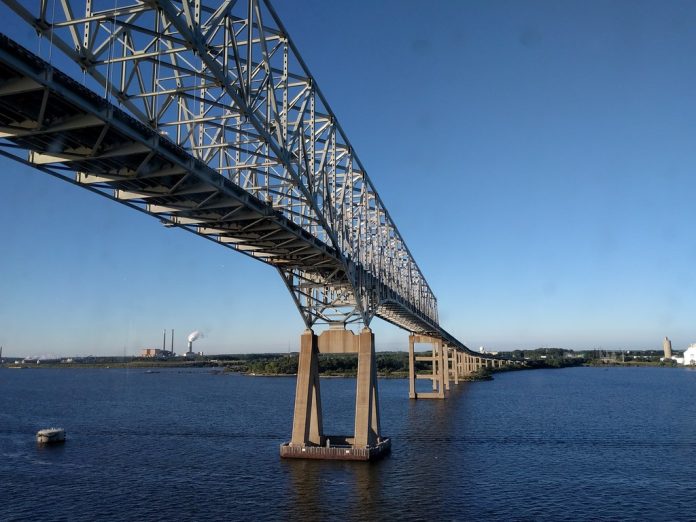Lessons from Maryland Key Bridge Collapse include: fix bridges before they are hit, and have users and insurers pay for safety upgrades.
by Robert Poole
The collapse of Maryland’s Francis Scott Key Bridge should be a wake-up call, not only for America’s highway and bridge owners/operators but also for the international maritime industry.
By now, it’s widely known that the Maryland Transportation Authority, owner/operator of this 1977 toll bridge, failed to absorb the lesson of the 1980 collapse of the Sunshine Skyway Bridge in Tampa, Florida, following a collision with a 580-ft.-long freighter called Summit Venture. Florida Department of Transportation (FDOT) replaced the aging truss bridge with a cable-stayed bridge and added large concrete “dolphins” to protect its piers from collisions with ships.
In 1991, the American Association of State Highway & Transportation Officials (AASHTO) released guidelines for major river bridges, which called for dolphins, among other safety measures. There is no evidence that the Maryland Transportation Authority ever seriously considered retrofitting dolphins to the Key Bridge. That’s odd. Because in the same Patapsco River, a state agency added dolphins to protect new electrical transmission lines.
And, today, the Delaware River & Bridge Authority is spending $95 million to add dolphins to its Delaware Memorial Bridge, serving Philadelphia’s port. They will be 80-ft.-diameter steel caissons filled with crushed rock. Compared with the costs of losing and replacing such a bridge, this appears to be a prudent investment.
I’m not a maritime engineer, so I cannot comment on whether dolphins of that size would stop or deflect one of today’s huge container ships. But here is how the Dali that hit the Key Bridge compares with the Summit Venture (Sunshine Skyway) and two of today’s largest container ships.
| Ship | Size | Length | Width |
| Summit Venture | 19.7K tons | 580 ft. | 86 ft. |
| Dali | 10K TEUs | 934 ft. | 160 ft. |
| Ever Given | 20K TEUs | 1312 ft. | 190 ft. |
| Irina | 24K TEUs | 1312 ft. | 210 ft. |
As you can see from the table, the Dali is smaller than the Ever Given (which got stuck in the Suez Canal) and the world’s current largest container ship, the Irina. Whether dolphins of the kind used on other bridges would be effective against today’s huge container ships remains to be seen. If they are not, other measures should be considered, such as requiring tugs to guide ships until they are safely past any harbor bridges. That’s a controversial topic in the maritime industry due to the cost, but bridge collapses are extremely expensive as we’ll be finding out in the aftermath of the Dali-bridge collision.
Who should pay for the Key Bridge’s replacement?
President Joe Biden jumped the gun by declaring that the federal government would foot the entire bill. That ignores a number of key points, including that the Key Bridge is a toll bridge whose replacement should be financed at least in part via toll revenue bonds. It also ignores a $350 million Maryland insurance policy on the bridge and ship insurance provided by Britannia P&I Club, one of about a dozen such insurance vehicles, according to The Wall Street Journal.
These clubs pool their resources in the event of a major disaster, and up to $3.1 billion is available per ship. President Biden’s hasty over-reaction has drawn some bipartisan opposition, including from Sen. Chuck Grassley (R-IA) and Rep. John Garamendi (D-CA). Rep. Garamendi told Bloomberg TV, “I don’t think this has to be federal taxpayer money. Let’s first go to the insurance side of it, and then we’ll see what’s left over.”
It’s far too early to put a price tag on the replacement bridge. The original Key Bridge cost only $316 million, but its flawed design must not be replicated. Its truss structure is “fracture critical,” meaning that if one structural element fails, the whole thing collapses. Only 2.8% of America’s bridges are fracture critical, but they include a number of major river-crossing bridges.
Since a whole new bridge will have to be designed, other decisions will have to be made: how high above the river, how many lanes, etc.—in addition, presumably, to dolphins and/or other safety measures.
Finally, let’s think about standards for ocean-going mega-ships. Dali, like nearly all container ships, was powered by a single diesel engine. When it failed, the ship lost motive power and electricity. This kind of single-point failure would never be allowed in an airliner. And that raises troubling questions about design and operating standards for major ocean-going ships. There seems to be no institutional safety certification and operational regulation as is standard worldwide in aviation. The International Maritime Organization issues “guidelines and recommendations” for national governments to consider, but there is no enforcement—in sharp contrast to international aviation.
While devising new institutions would be very complicated, there is a plausible alternative: maritime insurers. They bear the costs of disasters such as the destruction of the Key Bridge by a container ship. If any entity might be motivated to insist on more rigorous standards for ship design and operation, it’s maritime insurers. Let’s hope they take this catastrophe seriously.
Originally published by the Reason Foundation. Republished with permission.
For more great content from Budget & Tax News.











